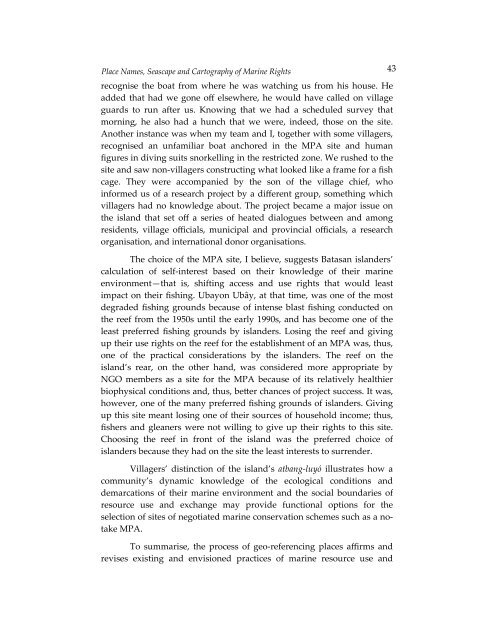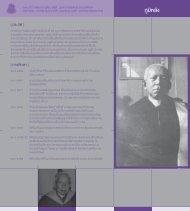Create successful ePaper yourself
Turn your PDF publications into a flip-book with our unique Google optimized e-Paper software.
Place Names, Seascape and Cartography of Marine Rightsrecognise the boat from where he was watching us from his house. Headded that had we gone off elsewhere, he would have called on villageguards to run after us. Knowing that we had a scheduled survey thatmorning, he also had a hunch that we were, indeed, those on the site.Another instance was when my team and I, together with some villagers,recognised an unfamiliar boat anchored in the MPA site and humanfigures in diving suits snorkelling in the restricted zone. We rushed to thesite and saw non-villagers constructing what looked like a frame for a fishcage. They were accompanied by the son of the village chief, whoinformed us of a research project by a different group, something whichvillagers had no knowledge about. The project became a major issue onthe island that set off a series of heated dialogues between and amongresidents, village officials, municipal and provincial officials, a researchorganisation, and international donor organisations.The choice of the MPA site, I believe, suggests Batasan islanders’calculation of self-interest based on their knowledge of their marineenvironment—that is, shifting access and use rights that would leastimpact on their fishing. Ubayon Ubây, at that time, was one of the mostdegraded fishing grounds because of intense blast fishing conducted onthe reef from the 1950s until the early 1990s, and has become one of theleast preferred fishing grounds by islanders. Losing the reef and givingup their use rights on the reef for the establishment of an MPA was, thus,one of the practical considerations by the islanders. The reef on theisland’s rear, on the other hand, was considered more appropriate byNGO members as a site for the MPA because of its relatively healthierbiophysical conditions and, thus, better chances of project success. It was,however, one of the many preferred fishing grounds of islanders. Givingup this site meant losing one of their sources of household income; thus,fishers and gleaners were not willing to give up their rights to this site.Choosing the reef in front of the island was the preferred choice ofislanders because they had on the site the least interests to surrender.Villagers’ distinction of the island’s atbang-luyó illustrates how acommunity’s dynamic knowledge of the ecological conditions anddemarcations of their marine environment and the social boundaries ofresource use and exchange may provide functional options for theselection of sites of negotiated marine conservation schemes such as a notakeMPA.To summarise, the process of geo-referencing places affirms andrevises existing and envisioned practices of marine resource use and43



